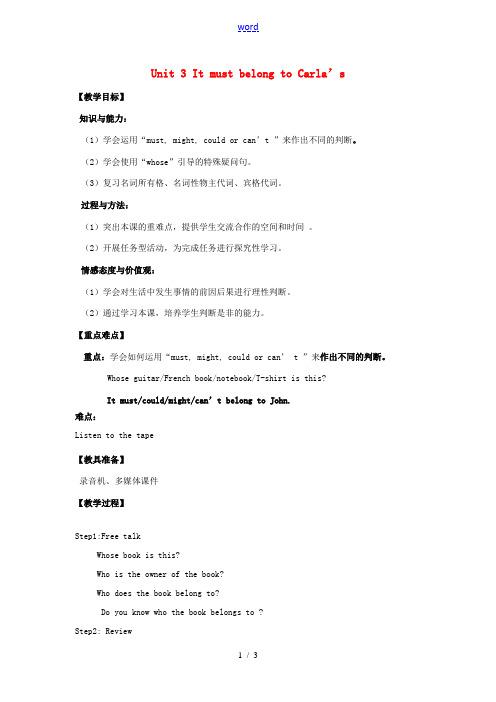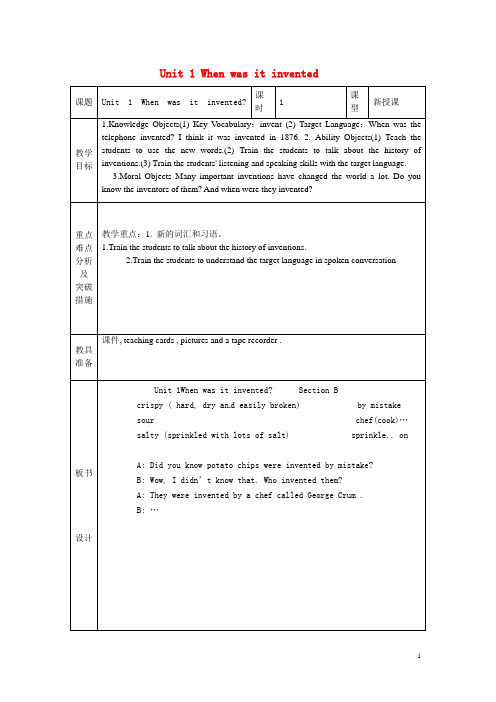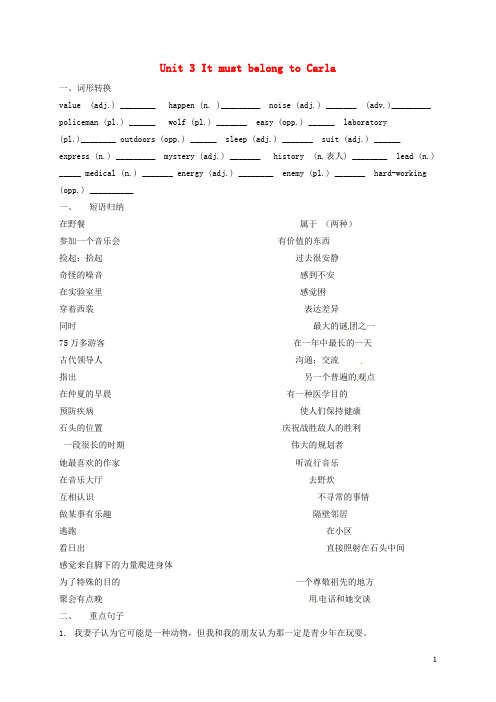山东省龙口市诸由观镇诸由中学九年级英语全册《Unit 3 It must belong to Carla’s》教案4 鲁教版五四制
- 格式:doc
- 大小:78.50 KB
- 文档页数:3

Unit 3 It must belong to Carla’s【教学目标】知识与能力:(1)学会运用“must, might, could or can’t ”来作出不同的判断。
(2)学会使用“whose”引导的特殊疑问句。
(3)复习名词所有格、名词性物主代词、宾格代词。
过程与方法:(1)突出本课的重难点,提供学生交流合作的空间和时间。
(2)开展任务型活动,为完成任务进行探究性学习。
情感态度与价值观:(1)学会对生活中发生事情的前因后果进行理性判断。
(2)通过学习本课,培养学生判断是非的能力。
【重点难点】重点:学会如何运用“must, might, could or can’ t ”来作出不同的判断。
Whose guitar/French book/notebook/T-shirt is this?It must/could/might/can’t belong to John.难点:Listen to the tape【教具准备】录音机、多媒体课件【教学过程】Step1:Free talkWhose book is this?Who is the owner of the book?Who does the book belong to?Do you know who the book belongs to ?Step2: ReviewLead the students to go over the phrases and the sentences. …………也不…….3或者…………另一些13.庆祝战胜敌人的伟大胜利 (celebrate)14……Step4:PairworkTwo students ask and answer the expressions in pairs.Step5: SummaryAsk students what we have learned this class.Step6: TestThe above phrases【作业设计】…………也不…….3或者……或7.太阳光线……另一些【板书设计】Useful phrases:……另一些【教学反思】本节课在教师合理地引导下对整个单元的短语进行了复习。

Unit 1 When was it invented课题Unit 1 When was it invented? 课时1课型新授课教学目标1.Knowledge Objects(1) Key Vocabulary:invent (2) Target Language:When was the telephone invented? I think it was invented in 1876. 2. Ability Objects(1) Teach the students to use the new words.(2) Train the students to talk about the history of inventions.(3) Train the students' listening and speaking skills with the target language.3.Moral Objects Many important inventions have changed the world a lot. Do you know the inventors of them? And when were they invented?重点难点分析及突破措施教学重点:1. 新的词汇和习语。
1.Train the students to talk about the history of inventions.2.Train the students to understand the target language in spoken conversation教具准备课件, teaching cards , pictures and a tape recorder .板书设计Unit 1When was it invented? Section Bcrispy ( hard, dry an d easily broken) by mistake sour chef(cook)…salty (sprinkled with lots of salt) sprinkle.. onA: Did you know potato chips were invented by mistake?B: Wow, I didn’t know that. Who invented them?A: They were invented by a chef called George Crum .B: …Step1 BrainstormingPlay guessing games: what inventions are they?One student comes to the front to guess, the others describe an invention shown on the screen using the passive sentences: It’s used for… It was invented by…It was invented in…etc.Take turns to show ‘light bulb, alarm clock, microwave oven’with some other helpful pictures that center about them nearby on the screen.(Purpose of desi gning: To guide the students to review what they learned last lesson)Step2 Leading-inT: The microwave oven reminds me of some delicious food. I will play a cartoon called “music food” My favorite food is in it. Try to guess what it is.Every time when they give a guess, I will express my like and dislike by using some adjectives like sweet, crispy, salty, sour . Make sure they know the meanings of them. For example:S:ChocolateT: It’s very crispy, but it’s too sweet. I don’t like it Can you guess the meaning of ‘crispy’? It describes food that is hard .dry and easily broken.S :Milk.T:I prefe r sour milk to milk. Do you know ‘sour’? Oranges sometimes taste sour.S: Fish.T: yes! Fish is my favorite, and I especially like salty fish that is sprinkled with a lot of salt.During this course, write down the new words on the blackboard..Finally play a leading role to read them.(Purpose :To arouse the students’ interest ,create useful situations for them to learn the new words.Prepare for the next step. )Step3 PracticeTask One writing1a.Show four food pictures on the screen and get the students to describe how th e food tastes and write them down.1b.Ask them to list the words of the food that has different tastes according to the headings on the screen as many as possible .sweet crispy salty sour The teacher moves around the classroom to provide help for the students who have troublein spelling some hard words and choose three students who write different words from one another.(Purpose: To practice using the target words and review the food words they have learnt before.)Task Two Speaking and actingGet the three students to the front, divide the class into four groups:Sweet Group , Crispy Group, Salty Group , Sour Group Game begins: The three students read their words loudly in class one by one without repetition, the group members should stand up as soon as they hear a word that belongs to them. Call out the students who stood up by mistake and have them guess the meaning of ‘by mistake’.(Purpose: This is employed to show the words they wrote and link the target words with the food words, and get the whole class moving.)esentationT: Just now you mentioned many kinds of food, bu t do you know there are some interesting stories behind them. Here is one.Ask the st udents to look at the picture in 2a and imagine what they are talking about.S: They are talking about the story of potato chips.T: Right .Maybe on the bag it says the invention of them!(Purpose: Cultivate their ability of imagination and present the invention of potato chips.)Step5 PracticeTask One Listening and understanding2a. Let the students look through the six sentences in the box and get some information from them. Then play the tape recording twice for them to listen and circle T or F. Check the answers.(Purpose: To provide practice in listening and understanding the target language in spoken conversation.)Task Two Listening and writing2b. Before playing the recording, get the stu dents to try to give answers by memory, or just by guessing. After a while, play the recording for them to fill in the missing words they hear. Then check the answers while concentrating on the new words: chef, sprinkle…on…(Purpose: To provide practice in understanding and writing the target language ,break through the difficult point.)Task Three Pairwork2c.Ask the students to make conversations using the information in 2a and 2b ,then ask some pairs to act them out. as follows:A: Did you know potato chips were invented by mistake?B: Wow, I didn’t know that. Who invented them?A: They were invented by a chef called George Crum.B: …(Purpose:Students are willing to show themselves and this task provides benefits for both more fluent and less fluent students to use the new language to talk with others and achieve the ability aim.)Task Four GroupworkT: Are you interested in the history of the sandwich?Show some pictures about the story of sandwiches on the screen, get them to discuss the history in groups of four as follows:Invention When was it invented? Who…by?Where…?How…?the sandwichThen each group choose a leader to give a report in class after that .(Purpose: This is employed to do further consoli dation and extension using the target language, it also fosters a sense of cooperation in the classroom.)Step6 HomeworkT: Think of a kind of food you like best and try an unusual way to cook at home and write your experience in your exercise book. And ask your parent to sign his/her name on your bo ok.(Purpose: The new type of homework is employed to relate the knowledge that they learn from this lesson with the life realities, and achieve the moral aims.)。

Unit 3 It must belong to Carla一、词形转换value (adj.) ________ happen (n. )_________ noise (adj.) _______ (adv.)_________ policeman (pl.) ______ wolf (pl.) _______ easy (opp.) ______ laboratory(pl.)________ outdoors (opp.) ______ sleep (adj.) _______ suit (adj.) ______ express (n.) _________ mystery (adj.) _______ history (n.表人) ________ lead (n.) _____ medical (n.) _______ energy (adj.) ________ enemy (pl.) _______ hard-working (opp.) __________一、短语归纳在野餐属于(两种)参加一个音乐会有价值的东西捡起;拾起过去很安静奇怪的噪音感到不安在实验室里感觉困穿着西装表达差异同时最大的谜团之一75万多游客在一年中最长的一天古代领导人沟通;交流指出另一个普遍的观点在仲夏的早晨有一种医学目的预防疾病使人们保持健康石头的位置庆祝战胜敌人的胜利一段很长的时期伟大的规划者她最喜欢的作家听流行音乐在音乐大厅去野炊互相认识不寻常的事情做某事有乐趣隔壁邻居逃跑在小区看日出直接照射在石头中间感觉来自脚下的力量爬进身体为了特殊的目的一个尊敬祖先的地方聚会有点晚用电话和她交谈二、重点句子1.我妻子认为它可能是一种动物,但我和我的朋友认为那一定是青少年在玩耍。
2.一定有某种东西闯入了我们的社区。
3.----这是谁的排球? ----它一定是卡拉的。
她喜欢排球。
4.----这是谁的发带?----它可能是梅的发带。
Unit 3 It must belong to Carla’s
【教学目标】
知识与能力:
(1)学会运用“must, might, could or can’t ”来作出不同的判断。
(2)学会使用“whose”引导的特殊疑问句。
(3)复习名词所有格、名词性物主代词、宾格代词。
过程与方法:
(1)突出本课的重难点,提供学生交流合作的空间和时间。
(2)开展任务型活动,为完成任务进行探究性学习。
情感态度与价值观:
(1)学会对生活中发生事情的前因后果进行理性判断。
(2)通过学习本课,培养学生判断是非的能力。
【重点难点】
重点:学会如何运用“must, might, could or can’ t ”来作出不同的判断。
Whose guitar/French book/notebook/T-shirt is this?
It must/could/might/can’t belong to John.
难点:
Listen to the tape
【教具准备】
录音机、多媒体课件
【教学过程】
Step1:Free talk
Step2:Learn Reading
Ask students to read the text quickly and answer the questions.
1.Do you think wh o build the Stonehenge?
2.Why was it built?
3.How many ideas are about the Stonehenge? What are they?
Step3:Explaining (show on the screen)
Expressions of Readi ng
1.不仅……而且
2.既不……也不…….
3或者……或者…… 4.一种日历
Two students ask and answer the expressions in pairs.
Check some students.
1.不仅……而且
2.既不……也不…….
3或者……或者…… 4.一种日历
5.在适当的位置
6.在仲夏的早晨
Step5: Important sentences.
1.每年来自全世界成千上万的游客参观巨石阵。
_______ year, ________ ________ _______ from _______ _______ the _______ visit Stonehenge.
2.这不仅是英国最著名的历史古迹之一,也是最伟大的神秘事物之一。
This is not only _______ of England’s ________ ________ _________ place s,_______ ________ one of _________ _________ _________ .
Step6: Summary
Ask students what we have learned this class.
Step7: Test
T he above sentences
【作业设计】
A. Let the students read and learn the words a nd expressions b y heart.
B. Let the students write down the important words and expressions in their notebooks.
C. Finish the gui der paper and listen to the tapes.
【板书设计】
1.每年来自全世界成千上万的游客参观巨石阵。
_______ year, ________ ________ _______ from _______ _______ the _______ visit Stonehenge.
2.这不仅是英国最著名的历史古迹之一,也是最伟大的神秘事物之一。
This is not only _______ of England’s ________ ________ _________ places,_______ ________ one of _________ _________ _________ .
【教学反思】
Most of the stud ents have grasped the words and expressions. They can use them freely. Fifteen students have got
Full marks in the test.
Only a few students can’t understand the following knowledge: one of the greatest mysteries thousands of tourists
Explain the difficulties to the students again .Then let the students do some more exercises.。